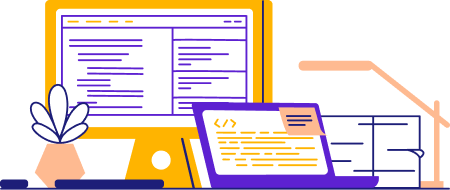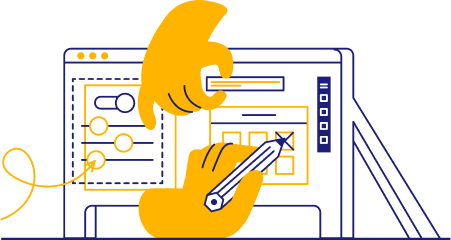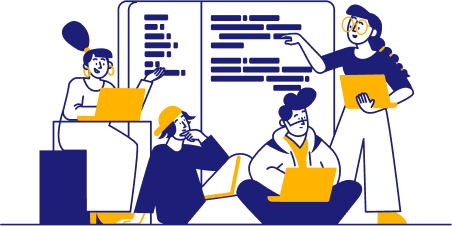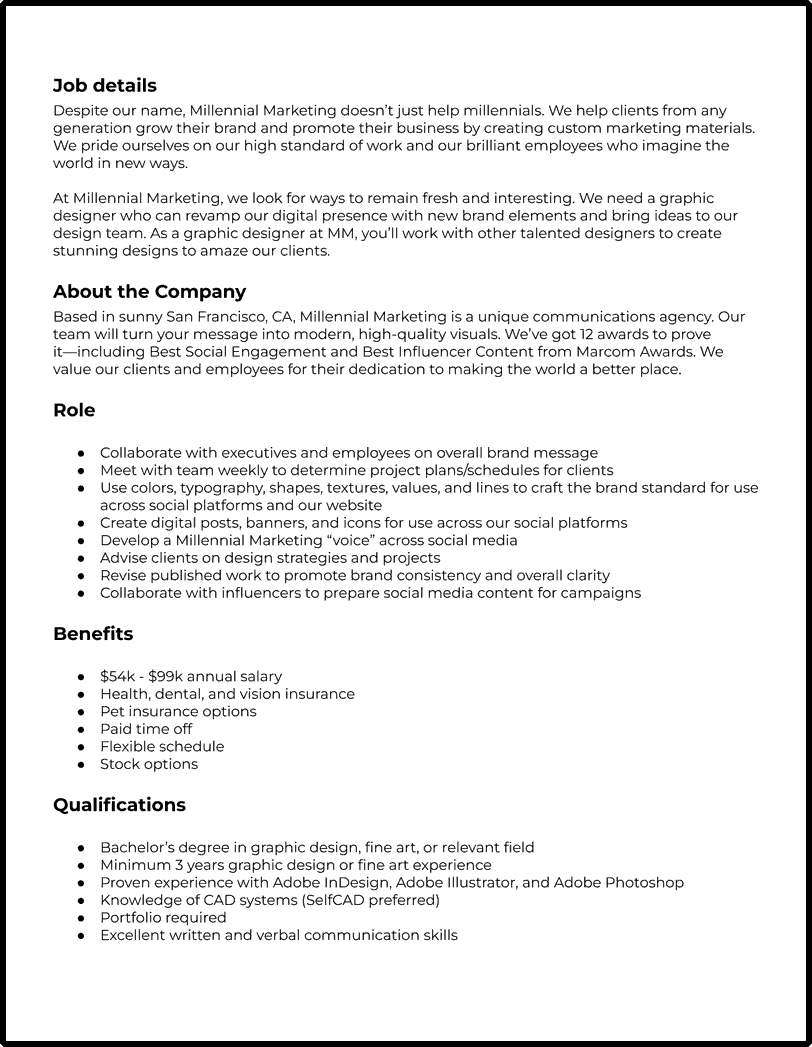Visual elements are a huge part of marketing and branding. Last year, HubSpot reported that 54% of consumers across four countries prefer to see videos over other content options. Users were 323% better at following instructions with text and images than just text.
That’s why hiring a graphic designer is so crucial. They transform abstract concepts into creations that inspire and educate customers and clients. Collaborating with multiple departments to produce high-caliber content in line with your company’s brand while meeting deadlines is all in a day’s work for a graphic designer.
Crafting a graphic designer job description doesn’t have to be intimidating. Use our tips and strategies to create content that entices the best graphic designers to apply.
Creating Your Graphic Designer Job Description

Job descriptions are the first contact a company has with their future employee, so they should be polished, professional, and personal. In reality, many job descriptions are painful and patronizing. They’re too long, too short, or too formal. Even worse, they’re generic. Here at BeamJobs, we’ve seen the good, the bad, and the ugly regarding job descriptions and want to help you create a job description that soars.
We first recommend including why you’re hiring. Has marketing been a little lackluster lately and in need of updating? Is the design team overloaded and needs someone to help design and print online material? By telling your readers what you need, they’ll know what to expect on the job.
Writing a stellar graphic design job description isn’t easy, but it’s worth it. TandemHR lists multiple benefits of a good job description, including protecting the company legally, helping you judge employee performance, and helping you find your ideal employee. Yellow adds that good job descriptions empower communication and clarify expectations. Your company’s reputation is at stake, so have a job description that showcases your good side.
Once you’ve listed the basics, go back and tailor the details. Just like applicants customize their graphic designer resumes, you should also make sure your job description personifies the qualities of a good graphic designer. This step may require some research to define the parameters of a graphic designer’s job. Keep adding until each section is complete, but resist the temptation to info-dump.
After writing, it’s time to revise. Eliminate anything irrelevant. Cut filler words unnecessary information, and spice up your word choice. If you have more than three sentences of story or background, it should be condensed. Graphic designers can make a story out of one sentence; so should you.
This is also the time to adjust formatting. It doesn’t have to be perfect, but it should be pleasing to the eye. Graphic designers make pieces that attract attention while not detracting from the message—strive for that same goal.
Next, hand it off for peer review. Graphic designers receive constructive criticism constantly. If they’re willing to take criticism to make their work better, you should, too.
Now it’s time to check for consistency, conciseness, and tone. Your job description should be informative, easy to read, and professional, but it should also be fun. The next step is to proofread. With their keen eye for detail, graphic designers can quickly spot errors, so ensure yours is error-free.
Lastly, submit your job description to job boards, double-checking its appearance and formatting on each site. Then watch the applications pile in! We bet you’ll have some great graphic designer cover letters that speak to you as a result.
To ensure you attract the best graphic designers, you need a job description that wows. Get ahead of the competition with a graphic design job description that’s fun, formal, and well-formatted.
Start with Our Graphic Designer Job Description Outline


Job details
First impressions count, and so does the first paragraph of your job description. That means you shouldn’t start with the sentence “Creative graphic designer needed immediately” with no follow-up information on the company (We’ve seen this multiple times).
Instead, introduce your company by listing your name and what role the applicant will fulfill. Don’t fall into the trap of using fancy and vague jargon. Graphic designers need to know what your business provides to design for you accurately.
After introducing your company, switch the focus to what you expect from your new graphic designer. This includes how they’ll help your company. Keep it brief, and save deeper details for later.

About the company
This section is where you’ll talk more in-depth about your business. You can cover a bit of your company’s history, goals, and vision. Still, everything you include needs to be tailored to your audience. Graphic designers communicate important messages with minimal text, so make that your goal.

What you’ll be doing
This is the cornerstone of your job description and likely the first thing applicants will read. Readers will scan this list and determine if they’re capable and willing to do what you ask. Thus, this section must be truthful, easy to read, and informative. Focus on essentials, and don’t include every task imaginable for the role. Use active verbs and concrete words to convey what the job will require.
- Create informative and entertaining graphics, photographs, audio, video, and other visual elements for visual communication media
- Source materials as needed for projects, including photography and web design assistance
- Collaborate with executives and employees on overall brand message

Qualifications
Second only to requirements, this is the most important part of your job description. It should list the credentials you require for the job ahead, including technical ability and soft skills. That doesn’t mean you should list every skill you’d prefer applicants have – too many qualifications can scare applicants away. Only include what’s necessary, and remember that many skills can be taught on the job.
- Bachelor’s degree in graphic design
- Proven experience with Adobe InDesign and Adobe Photoshop
- Intermediate experience with Microsoft Word, Excel, PowerPoint, and Outlook
- Strong interpersonal communication skills

Benefits
Listing your salary and other benefits can feel taboo, but it’s an excellent way to entice applicants. This tells future employees that they’ll be compensated fairly and treated well. Be specific about what you offer – vague phrases like “great company culture” and “wellness program offerings” are useless without concrete details.
A Graphic Designer’s Roles and Responsibilities

Graphic designers may be artists, but that’s not their only skillset. They are excellent communicators and visionaries who produce quality designs for multiple projects with tight deadlines. The daily life of a graphic designer requires them to fill many roles, including but not limited to those below.

Communicator
- Graphic designers spend a lot of time drafting designs and creating marketing masterpieces, but communicating is a huge part of their job. They collaborate with clients to write briefs, pitch ideas to their team, defend their design choices in meetings, and write text for their materials, among other tasks. Although their focus is visuals, they have to be excellent communicators to get their designs off the ground.
- Collaborate with marketing and design teams to conceptualize projects, write briefs, obtain materials, finalize designs, and frequently communicate the status of all projects with clients and stakeholders. May also be called to lead meetings regarding project status.
- This role will require strong written and verbal communication skills. Must also have a friendly and personable demeanor.

Brand advocate
- Brands are more than just images; images become a symbol for the company’s brand. Graphic designers must find a way to create a brand’s public identity. They must know the ins and outs of its message, unique offerings, current public perception, and future vision.
- Establish the company’s visual image using specific colors, typeface, and icons (including a logo) that adhere to the company’s brand and appeal to the target audience to increase public engagement. Will then create graphics, video, and audio materials with consistent brand elements.
- This role will require proven experience with Adobe InDesign, Illustrator, and Photoshop, along with strong attention to detail, creativity, and critical thinking.

Trend researcher
- Graphic designers look to grab positive attention, so trends are useful for driving engagement. Whether making a catchy video synced to the latest hit or updating the website to incorporate a new layout, graphic designers use what’s popular to get eyes on the company. That means spending time finding achievable trends and strategizing their implementation into company projects.
- Conduct market research on current social media and design trends, and strategize design ideas with the marketing team to create novel visuals that adhere to company standards and attract new audience members.
- This role will require strong time management and organizational skills and a detail-driven, creative personality. Must be familiar with popular social media sites, including YouTube, Twitter, Instagram, and Snapchat.

Mediator/negotiator
- Art is subjective, and graphic designers handle varying opinions constantly. Clients may insist on a poor design choice, executives may demand an impossible budget, or team members may not deliver the materials you need. Whatever the case, graphic designers must remain cool under pressure and still deliver high-quality work.
- Develop keen brand knowledge to maintain consistency across platforms, accept and implement revisions, present designs in client meetings, negotiate solutions to problems, collaborate with marketing and media teams to standardize brand, and collaborate with creative peers, executives, and clients to complete/finalize projects.
- This role will require strong written and verbal communication skills, critical thinking skills, and handling multiple projects under pressure.

Project manager
- Graphic designers are rarely working on just one project. At any given time, they might be conceptualizing a social media campaign, printing collateral materials, sketching a logo, or revising a website’s layout. They also work with peers to collect materials, edit designs, and brainstorm ideas to incorporate into their brand. They plan projects, foster team unity, advocate for the company, and communicate progress to relevant parties, making them effective project managers.
- Establish project terms, plan a project schedule, complete multiple projects per week as assigned, collaborate with sources (internal or external) to collect necessary materials, guide junior designers, approve projects before completion, and communicate with associated personnel to ensure satisfaction and quality projects.
- This role will require strong leadership, organization, and communication skills. Experience as a project manager preferred.

Expert proofreader
- Details are the name of the game for graphic designers, so proofreading is essential. Whether it’s one letter that’s in the wrong font, an alignment that’s not perfectly straight, or an uncomfortable color pairing, graphic designers spot minuscule mistakes and fix them. Clients may not notice until it’s too late, so it’s up to the designer to ensure there are no errors.
- Collaborate with design team and clients to critique projects, negotiate changes, and complete suggested edits. Must review all projects personally for adherence to the company brand, factual errors, design flaws, and client concerns before completion.
- This role will require strong verbal communication skills and attention to detail. Must be committed to quality and work well under pressure.

Social media master
- Social media is only the tip of the iceberg for graphic designers, but graphic designers have to be knowledgeable using multiple platforms as a key element in marketing. They also need to be aware of the audiences who use each platform and their content. Instagram needs different content than LinkedIn, and graphic designers must adjust accordingly.
- Conduct market research on social media trends and create 5 posts each for Facebook posts, Instagram, and LinkedIn. May be required to help draft 3-5 tweets per day to support other social posts.
- This role will require experience with Hootsuite, Adobe Photoshop, and Adobe Illustrator. Must also have excellent time management skills.








